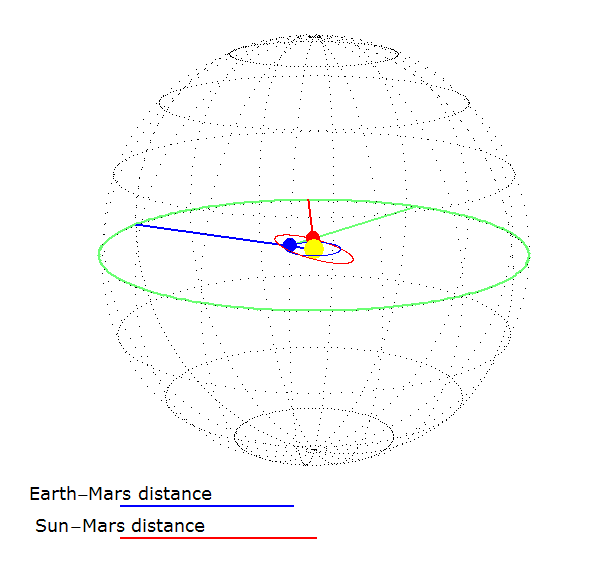Nodes and Inclination
Chapters 12 and 13
- Node
- Place on the planet's eccentric where it passes through the plane of the ecliptic.
"When the planet... is truly at the node, it can by no disposition of the sun or earth be made to appear elsewhere than at the node." (p.217) - Inclination
- "the angle at the sun... formed by lines drawn from the body of Mars and from its position on the ecliptic." (p.223)
The maximum inclination occurs at the limit, and is a characteristic of the orbit, not something measured each day. - Latitude
- "the angle under which any inclination appears when viewed from the earth." (p.223)
Animation:
Earth and Mars going about the sun. Lines are drawn from the sun through the Earth and Mars to the sphere of the stars, and from the Earth through Mars as well (green). The ecliptic is the blue line on the sphere, the inclination is red, and the observed latitude is green. There are only two times that the red inclination and the green latitude line up:
- When Mars is at the node -- when the inclination is on the ecliptic, so is the latitude
- When the distance between the Earth and Mars is the same as that between the Sun and Mars.
In chapter 13, Kepler uses (2) to find the inclination of Mars. By using observations when the Earth and Sun are equidistant from Mars, the inclination of Mars can be determined. If two people on a relatively level field are the same distance from an object, it will appear equally tall to them -- this is what your mind does all the time to estimate sizes and distances. If you see a person who looks tiny in your field of vision (latitude from head to toe), it is because the person is far away! Likewise, when a familiar object is large in your field of view, it is because it is close. Watch the blue and red bars at the bottom of the animation -- when they are equal, the inclination and latitude do indeed coincide. An interactive 3D animation is available here. Kepler also offers two other ways to determine inclination in chapter 13, available by clicking here.
